United Service Organizations
The United Service Organizations Inc. (USO) is an American nonprofit-charitable corporation that provides live entertainment, such as comedians, actors and musicians, social facilities, and other programs to members of the United States Armed Forces and their families. Since 1941, it has worked in partnership with the Department of War, and later with the Department of Defense (DoD), relying heavily on private contributions and on funds, goods, and services from various corporate and individual donors. Although it is congressionally-chartered, it is not a government agency.
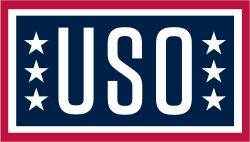 | |
| Founded | February 4, 1941[1] |
|---|---|
| Type | Services |
| Focus | The USO strengthens America's military service members by keeping them connected to family, home, and country, throughout their service to the nation. |
| Location |
|
Area served | 200+ centers worldwide |
Key people | J. D. Crouch II President and CEO |
Revenue | Donations (a 501(c)(3) non-profit) |
Volunteers | 30,000+ |
| Website | www.uso.org |
Founded during World War II, the USO sought to be the GI's "home away from home" and began a tradition of entertaining the troops that continues today. Involvement in the USO was one of the many ways in which the nation had come together to support the war effort, with nearly 1.5 million people having volunteered their services in some way. The USO initially disbanded in 1947, but was revived in 1950 for the Korean War, after which it continued, also providing peacetime services. During the Vietnam War, USO social facilities ("USOs") were sometimes located in combat zones.
The organization became particularly known for its live performances, called camp shows, through which the entertainment industry helps boost the morale of servicemen and women. From the start, Hollywood was eager to show its patriotism, and many celebrities joined the ranks of USO entertainers. They went as volunteers to entertain, and celebrities continue to provide volunteer entertainment, in military bases in the U.S. and overseas, sometimes placing their own lives in danger, by traveling or performing under hazardous conditions. In 2011, the USO was awarded the National Medal of Arts.
The USO has over 200 locations around the world in 14 countries (including the U.S.) and 27 states. During a gala marking the USO's 75th anniversary in 2016, retired Army Gen. George W. Casey Jr., the current chairman of the USO Board of Governors, estimated that the USO has served more than 35 million Americans over its history.[2][3]
History
Mission and goals
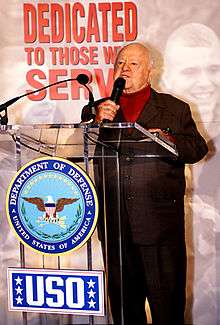
The USO was founded in 1941 by Mary Ingraham in response to a request from President Franklin D. Roosevelt to provide morale and recreation services to U.S. uniformed military personnel. Roosevelt was elected as its honorary chairman. This request brought together six civilian organizations: the Salvation Army, YMCA, Young Women's Christian Association (YWCA), National Catholic Community Service, National Travelers Aid Association and the National Jewish Welfare Board. They were brought together under one umbrella to support U.S. troops. Roosevelt said he wanted "these private organizations to handle the on-leave recreation of the men in the armed forces." According to historian Emily Yellin, "The government was to build the buildings and the USO was to raise private funds to carry out its main mission: boosting the morale of the military."[4]
The first national campaign chairman was Thomas Dewey, who raised $16 million in the first year. The second chairman was future senator Prescott Bush.[4] The USO was incorporated in New York on February 4,[1] with the first facility erected in DeRidder, Louisiana,1941.[5][6] More USO centers and clubs opened around the world as a "Home Away from Home" for GIs. The USO club was a place to go for dances and social events, for movies and music, for a quiet place to talk or write a letter home, or for a free cup of coffee and an egg.
The USO also brought Hollywood celebrities and volunteer entertainers to perform for the troops. According to movie historian Steven Cohan, "most of all ... in taking home on the road, it equated the nation with showbiz. USO camp shows were designed in their export to remind soldiers of home." They did this, he noted, by "nurturing in troops a sense of patriotic identification with America through popular entertainment."[7] An article in Look magazine at the time, stated, "For the little time the show lasts, the men are taken straight to the familiar Main Street that is the goal of every fighting American far away from home." Maxene Andrews wrote, "The entertainment brought home to the boys. Their home." Actor George Raft stated at the beginning of the war, "Now it's going to be up to us to send to the men here and abroad real, living entertainment, the songs, the dances, and the laughs they had back home."[7]
USO promotional literature stated its goals:
- "The story of USO camp shows belongs to the American people, for it was their contribution that made it possible. It is an important part in the life of your sons, your brothers, your husbands, and your sweethearts."[7]
In 2011, the USO was awarded the National Medal of Arts by President Barack Obama "for contributions to lifting the spirits of America's troops and their families through the arts".[8]
World War II
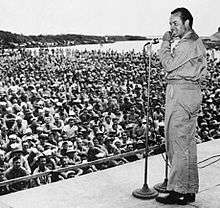
After being formed in 1941, in response to World War II, "centers were established quickly ... in churches, barns, railroad cars, museums, castles, beach clubs, and log cabins."[9] Most centers offered recreational activities, such as holding dances and showing movies. And there were the well-known free coffee and doughnuts. Some USO centers provided a haven for spending a quiet moment alone or writing a letter home, while others offered spiritual guidance and made childcare available for military wives.
But the organization became mostly known for its live performances called Camp Shows, through which the entertainment industry helped boost the morale of its servicemen and women. USO Camp Shows, Inc. began in October 1941,[10] and by that fall and winter 186 military theaters existed in the United States. Overseas shows began in November 1941 with a tour of the Caribbean. Within five months 36 overseas units had been sent within the Americas, the United Kingdom, and Australia, and during 1942 1,000 performed as part of 70 units. Average performers were paid $100 a week; top stars were paid $10 a day because their wealth let them contribute more of their talents.[11]
These overseas shows were produced by the American Theatre Wing, which also provided food and entertainment for the armed services in their Stage Door Canteens. Funds from the sale of film rights for a story about the New York Canteen went toward providing USO tours of shows for overseas troops.[12]
Following the Invasion of Normandy on June 6, 1944, Edward G. Robinson was the first movie star to travel to Normandy to entertain the troops.[13][14] He had already been active back home selling war bonds, and donated $100,000 to the USO. During his show, he said, "This is the most privileged moment of my life, the opportunity to be here with you."[15] The following month, Camp Shows began in Normandy.
Until fall 1944 overseas units contained five performers or fewer; The Barretts of Wimpole Street, using local theaters in France and Italy, was the first to use an entire theater company, including scenery.[11] At its high point in 1944, the USO had more than 3,000 clubs, and curtains were rising on USO shows 700 times a day. The USO's fundraising efforts were controversial. An MGM film, Mr. Gardenia Jones, created to assist the USO in its fundraising campaign, was nearly withdrawn from theaters due to objections by the War Department, mainly because of scenes showing soldiers jumping with joy at the opportunity to shower in canteens and rest in overstuffed and comfortable USO chairs. The Army, noted the New York Times, "feels this is not good for morale as it implies that there are no showers or other comforts for soldiers in military camps." The film starred Ronald Reagan, then a captain in the Army Air Force.[16]
Fundraising was also aided by non-USO entertainment groups. Soldier Shows, which troops – often experienced actors and musicians – organized and held their own performances, were common. The army formed a Special Services unit that organized such shows and supervised the USO, and the experience from the Soldier Shows led to Irving Berlin's Broadway show This Is the Army. Performers and writers from throughout the army were recruited for the production; they remained soldiers and continued drills. Berlin, who had written and produced the similar Yip, Yip, Yaphank during World War I, took the entire 165-person cast on tour in Europe in 1942, raising nearly $10 million for the Army Emergency Relief Fund. The following year the show was made into a film by the same title, again starring Ronald Reagan.[17][11] The This Is The Army stage production toured worldwide until it closed in October 1945 in Honolulu.[11]
War correspondent Quentin Reynolds, wrote in an article for Billboard magazine in 1943, that "Entertainment, all phases of it – radio, pictures and live – should be treated as essential. You don't know what entertainment means to the guys who do the fighting until you've been up there with the men yourself. ... You can quote me as saying that we should use entertainment as an essential industry so long as it's for the boys in service. Anybody who has been there would insist on it. ... Hell, you should have seen how happy the G.I.s were when they heard the ballplayers were coming over. And John Steinbeck, just back from a chore as war correspondent, ... also applauded show business as part of the war effort and its importance as a morale builder."[18]
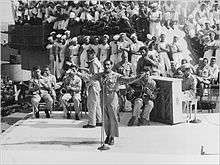
According to historian Paul Holsinger, between 1941 and 1945, the USO did 293,738 performances in 208,178 separate visits. Estimates were that more than 161 million servicemen and women, in the U.S. and abroad, were entertained. The USO also did shows in military hospitals, eventually entertaining more than 3 million wounded soldiers and sailors in 192 different hospitals. There were 702 different USO troupes that toured the world, some spending up to six months per tour.[19] In 1943, a United States Liberty ship named the SS U.S.O. was launched. She was scrapped in 1967.[20]
Twenty-eight performers died in the course of their tours, from plane crashes, illness, or diseases contracted while on tour.[11] In one such instance in 1943, a plane carrying a USO troupe crashed outside Lisbon, killing singer and actress Tamara Drasin, and severely injuring Broadway singer Jane Froman. Froman returned to Europe on crutches in 1945 to again entertain the troops. She later married the co-pilot who saved her life in that crash, and her story was made into the 1952 film With a Song in My Heart, with Froman providing the actual singing voice.[17] Others, such as Al Jolson, the first entertainer to go overseas in World War II, contracted malaria, resulting in the loss of his lung, cutting short his tour.[21]
One author wrote that by the end of the war "the USO amounted to the biggest enterprise American show business has ever tackled. The audience was millions of American fighting men, the theatre's location: the world, the producer: USO camp shows"[7] Performances continued after the end of the war in 1945. 60 new units went to Europe after V-E Day, and 91 new units went to the Pacific after V-J Day. The USO dissolved in December 1947, after having spent $240 million in contributions on Camp Shows, canteens, and other services. Special Services productions grew in number as replacement.[11]
In 1991, 20th Century Fox produced the film For the Boys, which told the story of two USO performers, and starred Bette Midler and James Caan. It covered a 50-year timespan, from the USO's inception in 1941 through Operation Desert Storm, in 1991. Another movie was planned in 1950 but never made. Just 10 days after Al Jolson returned from entertaining troops in Korea, he agreed with RKO producers to star in a new movie, Stars and Stripes for Ever, about a USO troupe in the South Pacific during World War II. Unfortunately, he died a week later as a result of physical exhaustion from his tour.
Women in the USO
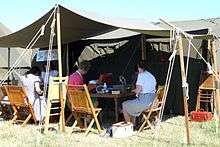
According to Emily Yellin, many of the key foot soldiers in the USO's mission were women who were "charged with providing friendly diversion for U.S. troops who were mostly men in their teens and twenties."[4] USO centers throughout the world recruited female volunteers to serve doughnuts, dance, and just talk with the troops. USO historian Julia Carson writes that this "nostalgic hour," designed to cheer and comfort soldiers, involved "listening to music – American style" and "looking at pretty girls, like no other pretty girls in the world – American girls."[22]
African-American women scrambled to rally the community around the soldiers and create programs for them. By 1946, hostesses had served more than two thousand soldiers a day while also providing facilities for the wounded and convalescent who were on leave. They went to black businesses and fraternal organizations in order to find sponsorship for their USO group, and later expanded to fulfill the needs of soldiers during the Korean War. Moreover, they worked to merge black and white USOs into one desegregated unit. As black historian Megan Shockley noted, "Their work for the desegregation of USOs had begun during World War II, and it finally paid off."[23]
Women were also key entertainers who performed at shows. Stars such as Marlene Dietrich, Judy Garland, Betty Grable and Rita Hayworth had traveled over a million miles. Yellin notes that on one tour, Hayworth visited six camps, gave thousands of autographs, and "came back from Texas with a full-fledged nervous breakdown from over-enthusiasm!"[4] Opera singer Lily Pons, after she had performed a "serious" opera song to troops in Burma, "an applause erupted that stunned even the most seasoned performers." She later wrote in a letter, "Every woman back home wears a halo now, and those who represent her had better keep theirs on, too."[4]
Author Joeie Dee pointed out that "for women entertainers, traveling with the USO made it possible to be patriots and adventurers as well as professionals." She adds, however, that the G.I.s in the USO audiences "tended to see these women in a different light – as reminders of and even substitutes for their girls back home, as a reward for fighting the war, as embodiments of what they were fighting for."[24] Edward Skvarna remembers 1943, when he met Donna Reed at a USO canteen and asked her to dance. "I had never danced with a celebrity before, so I felt delighted, privileged even, to meet her. ... But I really felt she was like a girl from back home." Jay Fultz, author of a biography of Reed, states that soldiers "often wrote to her as if to a sister or the girl next door, confiding moments of homesickness, loneliness, privation and anxiety."[25]
Women entertainers
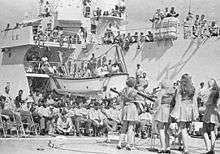
One female entertainer wrote about conditions while performing:
We've played to audiences, many of them ankle deep in mud, huddled under the ponchos in the pouring rain (it breaks your heart the first two or three times to see men so hungry for entertainment.) We've played on uncovered stages, when we, as well as the audience, got rain-soaked. We've played with huge tropical bugs flying in our hair and faces; we've played to audiences of thousands of men, audiences spreading from our very feet to far up a hillside and many sitting in the trees. ... We've played to audiences in small units of 500 or so, and much oftener to audiences of 8 to 10,000. Every night we play a different place.[4]
Singer-actress-dancer Ann Miller described performing for badly wounded soldiers. She did forty-eight shows for "broken soldiers," who were mostly lying on stretchers in the lobbies of hotels, watching as she entertained them. Yellin writes, "During her last show she collapsed and had to be taken home on an Army airplane."[4] Afterwards, Miller described the experience:
We went from ward to ward to ward, singing and dancing and trying to boost the morale of these men. It was just hell. ... I just fell apart and I think the shock of seeing those men with their arms and legs blown off – it was just frightening. But when you do it, you do it. You try to help them, try to sing and dance. You try to keep their spirits up. It's heartbreaking.[4]
Korean War
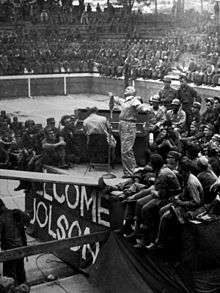
In 1947, the USO was disbanded,[26] due partly to lack of funds.[27] In 1951, when the United States entered the Korean War, Secretary of Defense George Marshall and Secretary of the Navy Francis P. Matthews requested that the USO be reactivated "to provide support for the men and women of the armed forces with help of the American people." According to war historian Paul Edwards, Between 1952 and 1953, not a day went by without the USO providing services somewhere in Korea. At home or overseas, in 1952 it was serving 3.5 million in the armed forces using much the same methods of operation as it did in World War II.
Many stars, both well-known and new, came to perform, including Bob Hope, Errol Flynn, Debbie Reynolds, Piper Laurie, Jane Russell, Paul Douglas, Terry Moore, Marilyn Monroe, Danny Kaye, Rory Calhoun, Mickey Rooney, Linda Coleman, Al Jolson and many others. Hispanic-American soldiers were entertained by artists such as Pérez Prado's Show featuring Evita Muñoz as his invited mambo dancer. Jolson was the first to volunteer, but due to lack of USO funds traveled to Korea at his own expense[28] (he was also the first to entertain troops during World War II).[29]
Veterans have recalled many of the USOs events, sometimes in vivid detail:
On that cold, overcast day, there were more than five thousand troops in the audience. They sat on the ground or up on the hillside. When everyone was settled, Danny Kaye opened the show by going to the microphone, looking at his large audience, and shouting, "Who's holding back the enemy?" The GIs roared with laughter. We were thrilled to have Kaye and his entertainers in our area. We especially liked the young women in the show. Danny was okay, with his stories and jokes, but after all, we knew what American men looked like.[31]:51
Author Linda Granfield in describing the show, writes, "For two hours, the men could forget they were soldiers at war. After the show, they returned to the fighting in the hills. Some in that audience never made it back."[31] By the end of the war, over 113,000 American USO volunteers were working at 294 centers at home and abroad.[32] And 126 units had given 5,422 performances to servicemen in Korea and the wounded in Japan.
Vietnam War
The USO was in Vietnam before the first combat troops arrived, with the first USO club opened in Saigon in April 1963. The 23 centers in Vietnam and Thailand served as many as a million service members a month, and the USO presented more than 5,000 performances during the Vietnam War featuring stars such as John Wayne, Ann-Margret, Sammy Davis Jr., Raymond Burr, Phyllis Diller, Martha Raye, Joey Heatherton, Wayne Newton, Jayne Mansfield, Redd Foxx, Rosey Grier, Anita Bryant, Nancy Sinatra, Jimmy Hawkins, Jimmy Boyd, Lola Falana, George Peppard and Bob Hope. Philip Ahn, the first actor of Korean descent to become a Hollywood star, became the first Asian American USO performer to entertain troops in Vietnam.[33]
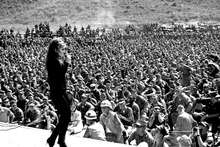
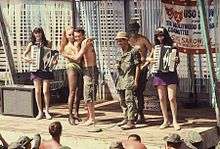
In addition, the USO operated centers at major U.S. airports to provide a lounge and place to sleep for American servicemen between their flights. Vietnam historian James Westheider noted that the USO "tried to bring a little America to Vietnam." Volunteer American civilians, who did 18-month tours, staffed the clubs. According to Westheider, "The young women wore miniskirts – no slacks were allowed." Each club had a snack bar, gift shops, a barbershop, photo developing, overseas phone lines, and hot showers.[34]
When providing entertainment, the USO did its best to attract known stars from back home to help relieve the stresses of war. Senator John Kerry recalled how important this kind of diversion would become. He remembered a "Bob Hope Follies" USO show, which included actress Ann-Margret, Miss America, football star Rosey Grier, and others. According to Kerry biographer Douglas Brinkley, "When the Swift finally made it back to the My Tho River, the crew confronted the heartbreaking sight of a huge Navy landing craft ferrying the troops back. The USO show was over." Kerry later wrote, "The visions of Ann Margret and Miss America and all the other titillating personalities who would have made us feel so at home hung around us for a while until we saw three Chinook helicopters take off from the field and presumed that our dreams had gone with them."[35]
But for GIs who saw the show, it was worth it: "We turned to watch Ann perform, and for about two minutes of American beauty, the war was forgotten. Everyone fully understood just what was really worth fighting for. ... The show was fantastic, but the escape the Bob Hope tour provided us in expectation for days before, and after, helped us keep in touch with what we were there for – God, Country, apple pie ... and Ann-Margret!"[36]
The visits by the stars meant a lot to the men and women in Vietnam. "It was not just the entertainment; it meant that they were not forgotten that far away from home," writes Westheider.[34] He adds that the tours made a "deep impression" on the stars as well. Singer and actress Connie Stevens remembered her 1969 tour with Bob Hope, when she decided to go despite the fact she had two children both under the age of two. Today, she claims that "veterans were still stopping her and thanking her for visiting Vietnam over 30 years later."[34]
Similarly, Ann-Margret during a book signing was approached by a veteran who asked her to sign a photo he took of her performing in Vietnam. Although the book's publishing representative for the signing event would not allow her to sign anything other than her book, the veteran's wife recalls:
She took one look at the photo, tears welled up in her eyes, and she said, 'This is one of my gentlemen from Viet Nam and I most certainly will sign his photo. I know what these men did for their country and I always have time for 'my gentlemen.'[37]
In November–December 1968 the Sig Sakowitz troop from Chicago performed over 36 shows in South Vietnam with the USO in: Pleiku, Dalat, Danang, Cam Ran Bay, Phu Bai, Phu Loy, Hue, Natrang, Tan Son Nhut Airbase, Saigon and places in the boonies known only to military intelligence and the lonely soldiers yearning for a taste of home. The troop consisted of Doublemint Twins Terrie and Jennie Frankel, Gaslight Club singer Sara Sue, Comedian Tony Diamond and personality Sig Sakowitz. Shows were also performed with comedian Joey Bishop of the Rat Pack.[38]
George Peppard, successful star of stage, TV and motion pictures, arrived in Vietnam for a USO HANDSHAKE TOUR in 1970 to visit the military in the hospitals and out in the "boonies."... He showed a keen interest in the men's mission while they were hungry for news of life back in the "World."... Polaroid pictures were taken by Mr. Peppard's escort officer, autographed, and given to the men.[39]
Lebanese peacekeeping
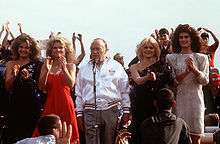
In 1983, a bloody civil war was raging in Lebanon. In an effort to stop the violence in the region a Multinational Force of peacekeepers composed largely of U.S., Italian and French armed service members was created and sent to the region to attempt a restoration of order. As part of the multinational force the United States mobilized an expeditionary force composed of members of the United States Marine Corps and elements of the United States Sixth Fleet which operated out of the Mediterranean Sea.[40]
Carrying on a tradition he had begun in World War II of spending Christmas with U.S. forces overseas, Bob Hope and his troupe of entertainers gave a show on board the battleship USS New Jersey on December 24, 1983. Four hundred Marines stationed in Beirut attended the show.[41]
Italy
American troops have been deployed in Italy since the end of World War II. In 1988, a car bomb targeted the USO club in Naples, which killed five people including a U.S. Navy officer.
Gulf War
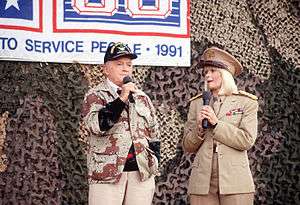
To support troops participating in Operation Desert Shield, USO centers opened in Saudi Arabia. Entertainers performing for the troops included Bob Hope, Jay Leno, Steve Martin, Delta Burke, Ann Jillian, Gerald McRaney, Marie Osmond, the Pointer Sisters, country singer Gina James, and Bob Hope on his final USO tour.[42]
Afghanistan and Iraq
To support troops participating in Operations Enduring Freedom and Iraqi Freedom, USO centers opened in Afghanistan, Iraq, Kuwait and Qatar. USO centers number more than 160 around the world. In those years, the USO opened centers at Fort Campbell, Kentucky; Fort Riley, Kansas; Fort Bliss, Texas; Fort Carson, Colorado; and Afghanistan. The USO provides a variety of programs and services, including orientation programs, family events, free Internet and e-mail access, free drinks and snacks, free phone calls home and recreation services. One of the newer programs, called "USO in a Box," delivers program materials ranging from DVD players and videos to musical instruments to remote forward operating bases in Afghanistan.
U.S. military personnel and their families visit USO centers more than eight million times each year.
Bruce Willis visited Baghdad, Camp Kir Kush and Camp Caldwell, Iraq around December 2003. Mr. Willis visited military bases in Iraq during his visit in Iraq.[43]
From June 8 to 11, 2009, TV personality Stephen Colbert traveled to Iraq to film his show The Colbert Report for four days in a USO sponsored event.
Other entertainers who have traveled to the Middle East to perform include Al Franken (who made six USO tours in Kosovo, Iraq and Afghanistan before being elected a United States Senator from Minnesota), Robin Williams, Craig Ferguson, Gary Sinise, Zac Brown, Five Finger Death Punch, Artie Lange, Gary Dell'Abate, Nick DiPaolo, Jim Florentine, Jim Norton, Dave Attell, Avenged Sevenfold, Jessica Simpson, Carrie Underwood, Drowning Pool, Toby Keith (with special guest Gina James), Montgomery Gentry, Kellie Pickler, Mayra Veronica, Carlos Mencia, O.A.R., Trace Adkins, Kathleen Madigan, Louis C.K.,[44] Dane Cook, Lewis Black, Third Day, Colin Quinn, Kathy Griffin and Neil McCoy.[45]
The USO has provided services for the annual "Tribute to the Troops" special of World Wrestling Entertainment. They have aired WWE RAW from Afghanistan and Iraq every Christmas in the United States in a pre-taped show from the combat zone.
On July 16, 2012, Hollywood actor Charlie Sheen announced that he would donate at least $1 million to the USO. This would be among the largest single monetary donations ever given to the organization.[46]
Honoring Bob Hope
In 1997, the U.S. Congress honored Bob Hope by declaring him the "first and only honorary veteran of the U.S. armed forces."[47][48] According to Hope biographer William Faith, his reputation has become ingrained in the "American consciousness" because he had flown millions of miles to entertain G.I.s during both wartime and peace. His contribution to the USO began in 1941 and ended with Operation Desert Shield in 1991, spending 48 Christmases overseas with American service personnel.[42] He was always treated as "an asset to the U.S. Government with his willingness to entertain whenever they needed him."[48] After WWII was declared over, the USO had sent out an "impassioned bulletin" asking entertainers not to abandon the GIs now that the war was over. Hope was among the first to say yes. The Military Order of the Purple Heart notes that "his contributions to the USO are well known: they are legend."[49]
As a result of his non-stop entertainment to both the civilian population and the military, he received numerous other honors over the years: a C-17 Air Force plane was named The Spirit of Bob Hope; a naval vessel was named the USNS Bob Hope; and streets, schools, hospitals, and a golf tournament were also named in his honor. A Senate resolution declared him "a part of American folklore." The Guinness Book of Records called him the most honored entertainer ever. And during his 1993 televised birthday celebration, when he turned 90, General Colin Powell saluted Hope "for his tireless USO trouping", which was followed by onstage tributes from all branches of the armed forces. General William Westmoreland spoke about his loyalty to the GI throughout the gritty Vietnam years. And bandleader Les Brown, who was with him during many of his tours, mentioned that his band "had seen more of Hope's ass in the last forty years than any of Hope's immediate family."[48]
War correspondent Quentin Reynolds wrote in 1943, "He and his troupe would do 300 miles in a jeep, and give four shows ... One of the generals said Hope was a first rate military target since he was worth a division; that that's about 15,000 men. Presumably the Nazis appreciated Hope's value, since they thrice bombed towns while the comic was there."[18]
During the Vietnam War years he gave a number of high-rating television specials and sensed that the media had given him a broad endorsement for continuing on his GI mercy missions. Soon after his Christmas show in Saigon in 1967, he learned that the Vietcong had planned a terrorist attack at his hotel against him and his entire troupe, missing him by ten minutes. He was later "mystified," writes Faith, "and ... increasingly intolerant of the pockets of dissent. Draft-card burnings on college campuses angered him ..." "Can you imagine," Hope wrote in a magazine article, "... that people in America are burning their draft cards to show their opposition and that some of them are actually rooting for your defeat?"[48] In the spring of 1973, Hope began writing his fifth book, The Last Christmas Show, which was dedicated to "the men and women of the armed forces and to those who also served by worrying and waiting." He signed over his royalties to the USO.
His final Christmas show was during Operation Desert Shield in 1990. The show was not easy, notes Faith. "There were so many restrictions. Hope's jokes were monitored by the State Department to avoid offending the Saudis ... and the media was restricted from covering the shows ... Because in Saudi Arabia national custom prescribes that women must be veiled in public, Ann Jillian, Marie Osmond, and the Pointer Sisters were left off Hope's Christmas Eve show."[48]
In 2009, Stephen Colbert performing his last episode of weeklong taping in Iraq for his The Colbert Report show, carried a golf club on stage and dedicated it to Bob Hope's service for the USO.
Financial matters
The USO has a paid staff of approximately 300. Additionally, more than 44,000 USO volunteers provide an estimated 371,417 hours of service annually. As reported by the USO, the unpaid volunteer to paid employee ratio overseas is 20 to 1. Within the United States, the number is "significantly higher."
The following information is based on USO's audited financial statements[50] for the year ended December 31, 2011:
| Total Revenue and Other Support | U.S. $350,426,940 |
|---|---|
| Grants | 18,250,129 |
| Direct response | 61,564,019 |
| USO center revenue | 7,834,849 |
| Corporate, foundation and individual giving | 29,501,369 |
| Investment income | (178,103) |
| United Way and CFC | 2,106,253 |
| Contributed materials, facilities and services | 231,585,773 |
| Total Operating Expenses | U.S. $334,068,520 |
|---|---|
| Program expenses | 300,456,722 |
| Fund raising expenses | 20,098,767 |
| Administrative expenses | 13,513,031 |
See also
- Gilla Gerzon (Former director, USO Haifa)
- United Service Organization of North Carolina
References
- "Our Proud History: Important Dates in USO History". USO Web Site. USO Inc. Retrieved May 17, 2010.
- "From World War II to Afghanistan: USO Marks 75th Anniversary", Department of Defense, February 5, 2016
- "Happy 75th Anniversary USO!", Huffington Post, February 4, 2016
- Yellin, Emily. Our Mothers' War: American Women at Home and at the Front During World War II, Simon and Schuster (2005)
- John Whiteclay Chambers II. "USO." The Oxford Companion to American Military History. Oxford University Press (2000), highbeam.com
- Nash, Bill. High Hat Sam: The Life and Times of Louisiana Governor Sam Houston Jones. Springfield, Missouri : James E. Cornwell, 2014. p. 102.
- Cohan, Steven. The Road Movie Book, Routledge (1997)
- "USO (United Service Organizations)". National Endowment for the Arts. December 10, 2012. Retrieved March 27, 2020.
- Clairday, Robynn. Postcards from World War II, Square One Publishers (2001)
- WWII USO Preservation Association. History: USO Camp Shows, Inc., accessed 15 Dec 2017.
- Matson, Lowell (1954). "Theatre for the Armed Forces in World War II". Educational Theatre Journal. 6 (1): 1–11. doi:10.2307/3204158. JSTOR 3204158.
- "Who is 'Tony'?". TonyAwards.com. The American Theatre Wing's Tony Awards®. June 28, 1946. Retrieved November 4, 2013.
- Ross, Steven J., "Little Caesar and the McCarthyist Mob" Archived November 14, 2016, at the Wayback Machine, USC
- "Photo of Edward G. Robinson entertaining troops in Normandy".
- Robinson, Edward G. All My Yesterdays, Hawthorn Books (1973) p. 240
- Pryor, Thomas. New York Times, June 28, 1942
- Goldstein, Richard. "Answers About World War II in New York" New York Times, September 29, 2010
- "Quentin Reynolds Talks on Terrific Job Big and Little Showbiz is Doing Overseas", Billboard, October 30, 1943 p. 4
- Holsinger, Paul. War and American Popular Culture: a Historical Encyclopedia, Greenwood Publishing Group (1999)
- Reading 1: Liberty Ships National Park Service Cultural Resources.
- Abramson, Martin. "Jolson Sings Again", The Real Al Jolson (1950)
- Carson, Julia. Home Away From Home: The Story of the USO, Harper & Brothers (1946)
- Shockley, Megan Taylor. We, Too, are Americans: African American Women in Detroit and Richmond, 1940–55, Univ. of Illinois Press (2004)
- Dee, Joeie. Hi GI, Xulon Press (2005)
- "Dear Donna: A Pinup So Swell She Kept G.I. Mail", New York Times, May 24, 2009
- "The Organization".
- Freedland, Michael. The Story of Al Jolson (1972), pp. 283–84
- Akst, Harry "The Jolson Nobody Knew", Cosmopolitan, January 1951
- Woolf, S.J. "Army Minstrel", New York Times, September 27, 1942
- "Marilyn Monroe Ends Korea Swing". Stars and Stripes. Stripes.com. February 23, 1954. Retrieved May 6, 2018.
- Granfield, Linda. I Remember Korea: Veterans Tell Their Stories of the Korean War, 1950–53 Houghton Mifflin Harcourt (2003)
- Edwards, Paul M. The Korean War, Greenwood Publishing Group (2006)
- Chung, Hye Seung. Hollywood Asian, Temple Univ. Press (2006)
- Westheider, James E. The Vietnam War, Greenwood Publishing Group (2007)
- Brinkley, Douglas. Tour of Duty: John Kerry and the Vietnam War HarperCollins (2004)
- War-Stories.com
- "Ann-Margret ... The Real WOMAN OF THE YEAR", jdeaustocp blog, April 26, 2013
- "Terrie Maxine Frankel: Digital Collection: Veterans History Project (Library of Congress)". Lcweb2.loc.gov. October 26, 2011. Retrieved November 4, 2013.
- Credit USO Photo/Vietnam
- Levins, Hoag (October 18, 2001). "Launch your own missile from Battleship New Jersey: Warship Museum Prepares New 'Interactive' Combat Control Center". HistoricCamdenCounty.com. Retrieved May 21, 2007.
- Frank, Benis M. (1987). U.S. Marines in Lebanon 1982–1984 (PDF). History and Museums Division, Marine Corps. p. 90. LCCN 87-619851. Archived from the original (PDF) on August 12, 2014.
- Edward J. Marolda and Robert John Schneller (2001). Shield and sword: the United States Navy and the Persian Gulf War. Naval Institute Press. p. 163. ISBN 1-55750-485-7.
- "Robert J Hudson, Master Sergeant USMC Retired. MSgt. Hudson was Commanding Officer (contracted Major in USA) for First Company Commander for first and Second and Battalion for the New Iraq Army training Program. in the NIATP (New Iraqi Army Training Program) under Vinnell Corporation, Program Director Lieutenant General George Allen Crocker (when meeting Mr Willis)". mrfa.org. Archived from the original on November 16, 2012. Retrieved May 7, 2013.
- Louis C.K's USO Blog, louisck.net Archived July 22, 2010, at the Wayback Machine
- "2006 to 2009 Tour Schedule". Archived from the original on January 29, 2010. Retrieved January 22, 2010.
- "Actor Charlie Sheen gives $1M to troops, USO". CNS News. Archived from the original on October 4, 2013. Retrieved July 17, 2012.
- "Bob Hope: First and only honorary veteran of the Armed Forces", Army Live, August 19, 2014
- Faith, William. Bob Hope: A Life in Comedy, Da Capo Press (2003)
- Military Order of the Purple Heart, Legacy of the Purple Heart, 4th Ed., Turner Publishing Co. (2001)
- "USO.org". Archived from the original on September 30, 2010. Retrieved October 4, 2010.
External links
| Wikimedia Commons has media related to United Service Organizations. |
- Official website
- bobhopeuso.org
- USO Clubs in World War II
- "Entertaining the Troops" film, public television, 1 hour
- Bob Hope USO studio show video recording
- Movie clips: WWII tour, from Jolson Sings Again (1949)
- USO World Gala, 2008: President Bush speech Text and video, October 1, 2008
- The short film Big Picture: United Service Organization (USO): Wherever They Go is available for free download at the Internet Archive
- The short film Staff Film Report 66-25A (1966) is available for free download at the Internet Archive
- The short film USO – 30 Years of Service (1971) is available for free download at the Internet Archive
- USO Camp Shows publicity records, 1941–1955, held by the Billy Rose Theatre Division, New York Public Library for the Performing Arts
- United Service Organizations, Inc. : hearing before the Subcommittee on Administrative Law and Governmental Relations of the Committee on the Judiciary, House of Representatives, Ninety-fourth Congress, first session ... December 9, 1975.